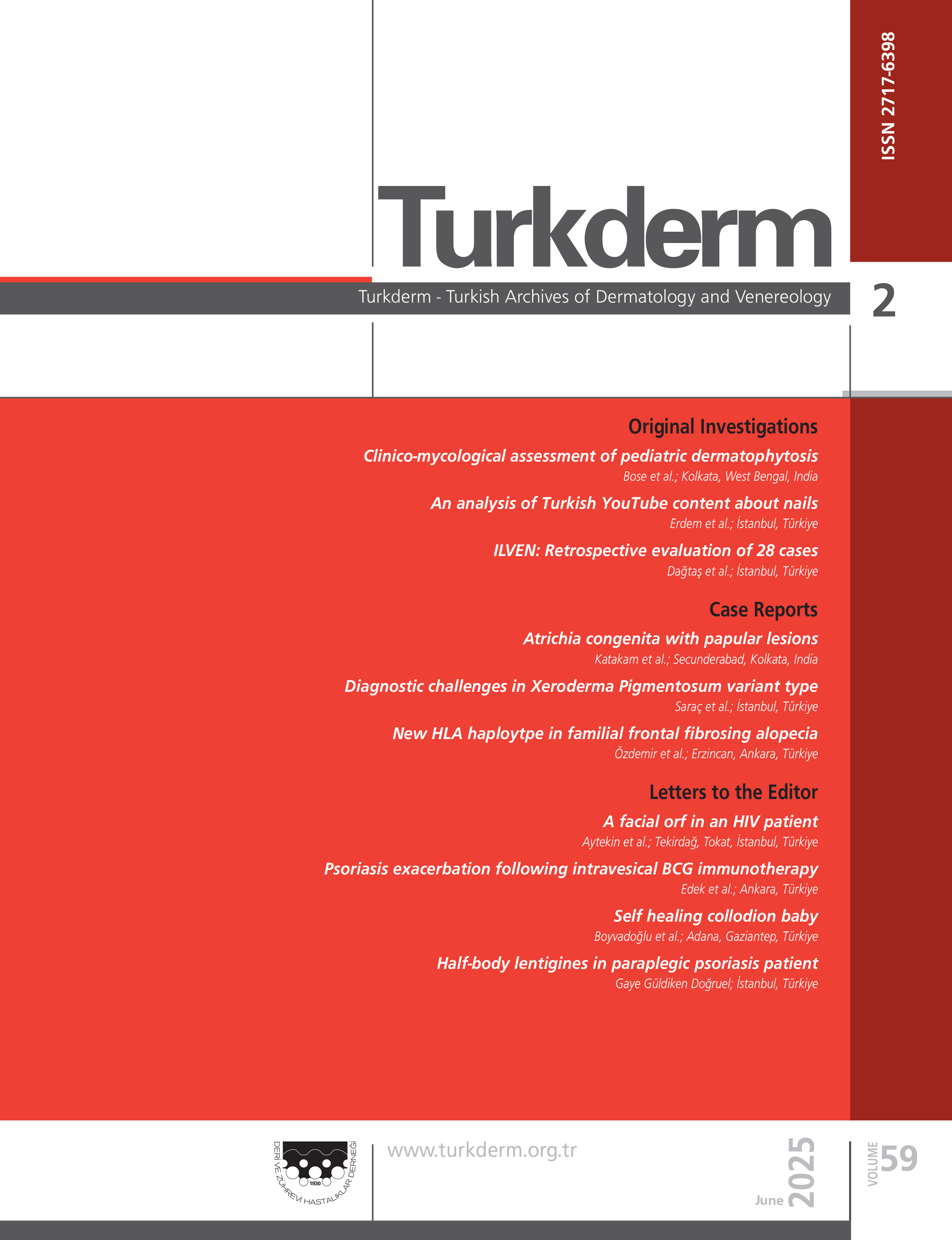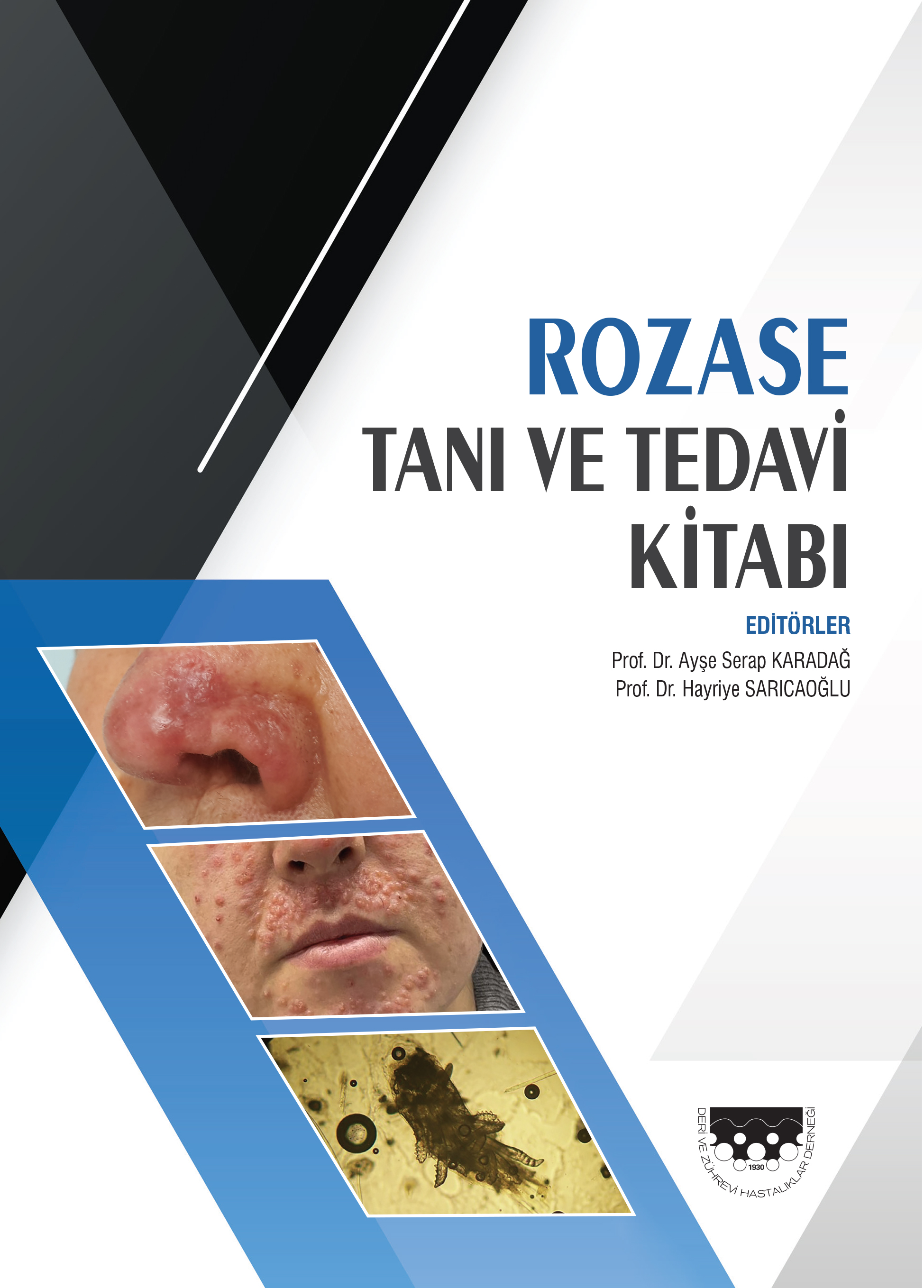Volume: 57 Issue: 2 - 2023
| 1. | Cover Pages I - VI |
| ORIGINAL INVESTIGATION | |
| 2. | Monocyte/high-density lipoprotein cholesterol, neutrophil/high-density lipoprotein cholesterol, and lymphocyte/high-density lipoprotein cholesterol ratios as new inflammatory markers in rosacea Bülent Nuri Kalaycı doi: 10.4274/turkderm.galenos.2023.50146 Pages 38 - 42 Background and Design: Rosacea is a chronic inflammatory skin disease. The monocyte/high-density lipoprotein (HDL) cholesterol ratio (MHR), neutrophil/HDL cholesterol ratio (NHR), and lymphocyte/HDL cholesterol ratio (LHR) are new inflammatory parameters associated with inflammatory diseases. This study aimed to compare MHR, NHR, and LHR between patients with rosacea and healthy controls and determine the relationship of these parameters with disease severity. Materials and Methods: The study retrospectively included 82 patients who presented to our hospital with rosacea and 82 healthy controls. The MHR, NHR, and LHR of the patient and control groups were calculated. Patients were divided into groups according to the clinical subtypes, disease severity, and presence of Demodex mites. Results: Of the 82 patients included in the study, 62 (75.6%) were female and 20 (24.4%) were male, and their mean age was 41.95±1.2 (22-65.43) years. The mean MHR values of the rosacea and control groups were 0.01±0.005 and 0.009±0.003, respectively, and the difference was statistically significant (p=0.01). The mean NHR values of the rosacea and control groups were 0.10±0.05 and 0.08±0.02, respectively, and the difference was statistically significant (p=0.04). The mean LHR values of the rosacea and control groups were 0.05±0.02 and 0.04±0.01, respectively, indicating no statistically significant difference (p>0.05). For the prediction of patients with rosacea, the cut-off MHR was calculated as 0.009 (67% sensitivity and 60% specificity) and that of NHR was 0.08 (64% sensitivity and 60% specificity). Conclusion: The results reveal that MHR and NHR parameters can be used as indicators of systemic inflammation in patients with rosacea. |
| 3. | Evaluation of skin barrier functions in patients with breast cancer-related lymphedema: Measurement of stratum corneum hydration, sebum level, and transepidermal water loss Münevver Güven, Engin Taştaban, Meltem Uslu, Ekin Şavk, Neslihan Şendur doi: 10.4274/turkderm.galenos.2023.19794 Pages 43 - 47 Background and Design: Skin barrier function in patients with breast cancer-related lymphedema (BCRL) has rarely been evaluated. This study aimed to investigate transepidermal water loss (TEWL), stratum corneum hydration (SCH), and sebum level (SL) on the skin of the lymphedema arm in comparison to the skin of the healthy contralateral arm in BCRL patients. Materials and Methods: This cross-sectional study included 40 female patients with unilateral BCRL. TEWL, SCH, and SL were measured using Tewameter®, Corneometer®, and Sebumeter®, respectively. Measurements were taken in each patient's lymphedema arms and healthy contralateral arm. The volar/dorsal regions of the forearm and the dorsal region of the upper arm were determined as measurement sites. Results: In all three measurement areas, there was no significant difference in SCH or SL between the skin of the lymphedema arm and the skin of the healthy contralateral arm. TEWL was significantly higher on the skin of the lymphedema arm than on the healthy arm for the volar forearm regions (p=0.007). However, there was no significant difference in TEWL between the skin of the lymphedema arm and the skin of the healthy contralateral arm in the dorsal forearm or dorsal upper arm region. Conclusion: This study showed that there was no difference in skin barrier functions in the lymphedema arm compared with the healthy contralateral arm, except for higher TEWL in the skin of the volar forearm region of the lymphedema arm in BCRL patients. The detection of changes in skin barrier function in BCRL patients may help in the regulation of optimal skin care of these patients lymphedema arms. |
| 4. | Evaluation of bone marrow functions and new inflammatory markers in patients with immunocompetent herpes zoster Esma İnan Yüksel, Demet Çiçek, Betül Demir, Ozan Erdem doi: 10.4274/turkderm.galenos.2023.73004 Pages 48 - 54 Background and Design: Herpes zoster (HZ) is a viral infection characterized by dermatomal vesicles caused by the reactivation of the latent varicella-zoster virus (VZV). There are conflicting reports regarding the effects of VZV on bone marrow functions. In this study, we aimed to evaluate bone marrow function and systemic inflammation in immunocompetent HZ patients. Materials and Methods: This study included patients aged ≥18 yr diagnosed with HZ and admitted to a dermatology outpatient clinic between June 2011 and June 2021. Hematological parameters in routine hemogram tests of patients with HZ and new inflammatory markers, such as neutrophil-to-lymphocyte ratio (NLR), platelet-to-lymphocyte ratio (PLR), systemic immune inflammation index, and platelet-neutrophil ratio (PNR), were determined and compared with healthy control groups. Results: Thrombocytopenia was observed in 6.1% and lymphopenia in 8% of 461 HZ patients. The mean leukocyte (white blood cell), lymphocyte, neutrophil, eosinophil, and platelet (PLT) counts in HZ patients were statistically significantly lower than in the control group (p<0.05). NLR and PLR values were statistically significantly higher in HZ patients than in the control group (p<0.05). PLT, eosinophil count, and PNR values were statistically lower in HZ patients aged ≥65 yr than in patients aged <65 yr, whereas mean platelet volume and NLR values were higher (p<0.05). Conclusion: Thrombocytopenia and lymphopenia may occur in immunocompetent HZ patients. NLR and PLR values increase in HZ patients. The increase in inflammatory markers and decrease in platelet count are more evident in HZ patients aged ≥65 yr. |
| 5. | Sleep quality in patients with chronic spontaneous urticaria Fatma Etgü, Sevda Önder doi: 10.4274/turkderm.galenos.2023.56563 Pages 55 - 60 Background and Design: Chronic urticaria is characterized by the occurrence of hives (wheals) and/or angioedema for 6 weeks or more. Materials and Methods: This was a cross-sectional study. All participants were asked to complete the Epworth Sleepiness Scale (ESS), Pittsburgh Sleep Quality Index (PSQI), and Insomnia Severity Index (ISI). Patients with chronic spontaneous urticaria (CSU) completed the Urticaria Activity Score 7 (UAS-7) and Chronic Urticaria Quality of Life Questionnaire. Results: The study included 88 patients with CSU (26 men and 62 women) and 88 healthy controls (26 men and 62 women). The mean global PSQI score was 7.27±4.54 in the patient group and 4.97±2.82 in the control group (p<0.001). The mean ISI score was significantly higher in the patient group than in the control group (p=0.001). The mean ESS score did not differ between the patient and control groups (p=0.262). Conclusion: In this study, we found that more people in the patient group experienced poor sleep quality and insomnia compared with the control group. In the patient group, female sex, presence of CSU for more than 5 years, and presence of angioedema were associated with poor sleep quality. Patients with severe disease (high UAS-7 scores) had worse sleep quality. The erythrocyte sedimentation rate was found to be correlated with sleep disturbance. |
| 6. | Serum osteopontin levels in patients with psoriasis vulgaris and its relation with oxidative stress Cem Kılınç, Selma Korkmaz, Gülben Sayılan Özgün, Sezin Fıçıcıoğlu, Süleyman Pişkin doi: 10.4274/turkderm.galenos.2023.92845 Pages 61 - 65 Background and Design: Oxidative stress is known to play a role in the etiopathogenesis of psoriasis. Recent data suggest that osteopontin (OPN) can also play a role in the pathogenesis of psoriasis. In the current study, OPN levels and oxidative stress were evaluated in patients with psoriasis. Materials and Methods: The study included 61 patients with psoriasis and 62 healthy controls. The OPN levels, total antioxidant status (TAS), total oxidant status (TOS), and oxidative stress index (OSI) were measured using serum. The disease severity was evaluated using the psoriasis area and severity index (PASI). Results: No statistically significant differences in OPN, TAS, and OSI values were identified between the psoriasis and control groups. A negative correlation was found with the TAS. There was no statistically significant correlation between the PASI score and OPN, TAS, TOS, and OSI values. Conclusion: We did not find a statistically significant correlation between OPN levels and oxidative stress in patients with psoriasis. We believe that larger and more detailed studies are needed to highlight the role of OPN and oxidative stress in the etiopathogenesis of psoriasis. |
| LETTER TO THE EDITOR | |
| 7. | Two cases of generalized bullous fixed-drug eruption triggered by etodolac Işıl Göğem İmren, Şule Gökşin, Merve Akbay, Sevilay Ertürk, Neşe Çallı Demirkan, Şeniz Duygulu doi: 10.4274/turkderm.galenos.2023.14603 Pages 66 - 68 Abstract | |
| 8. | How to perform the whole nail unit excision and grafting? Ozan Erdem, Yusuf Kelleci, Begüm Çalım Gürbüz, Fatih Göktay doi: 10.4274/turkderm.galenos.2023.34101 Pages 69 - 72 Abstract | |























